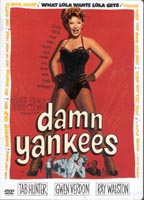
Damn Yankees |

DAMN YANKEES
1958
Cast: Ray Walston, Gwen Verdon, Tab Hunter
George Abbott (director) famous Bway director
Genre: MUSICAL, COMEDY, SPORTS
Musicals: Diagetic music where it wouldn’t occur normally.
Problems of “reality”. Americans not big on expressionism. Musicals violate reality canon by breaking in song and dance “unnaturally”.
How does the film get into the musical numbers?
Is there a difference between durchkomponiert scores (those which are "through composed: - that is there is little dialog virtually everything is sung - and musicals where there are specific "songs" or "numbers" which are ni the middle of spoken dialog.
Do the people in plays/films like Damn Yankees think of the person who is singing as singing? Or do they regard them as talking?
This is a problem that has to do with expectations of the genre. If you accept the genre rules that people "break into song" unexpectedly and urealistically, then there is no problem. If you can't make that leap, then there is. This is what seems to be the problem for American audiences, Possibly it explains why durchkomponiert films have appeared (Evita, Moulin Rouge Phantom of the Opera) although they haven't been wildly popular.
Originally a Broadway show with basically the same cast, although Tab Hunter was the “name” star brought in to the film.
Differences between Broadway and film:
Sets rather static (films can “open up” stage) Distance is set from viewer to stage (no close-ups possible without special techniques – projections, etc.) Acting different. Distance a problem. Attractiveness (pretty/handsome) less significant because of distance. Musicals fare better on Broadway than in film.
SPORTS FILMS: Is this actually a genre? Often related to "Coming of Age films" Are these a genre?
Damn Yankees
Another “contract with the devil” film.
Who makes the contract? Why?
AFTER THE FILM
Musical Aspects
TEXT AND FILM ASPECTS
Devil – How dies he appear? appearance, behavior (funny, scary). Throws temper tantrums
Devil= Mr. Applegate (apple from garden of Eden)
Joe Hardy - everyday Joe - an everyman. Joe (possibly from Shoeless Joe Jackson, a White Sox player who was on a team that "threw" the World Series in 1919. It appears he was not guilty, but was banned from baseball and the Baseball Hall of Fame.
Hardy = strong, healthy etc. A "proper" name for an athlete. Lola: To what does she appeal? How is this a “satanic” value? What can be said about the relationship between things the Devil offers and what Christianity holds evil?
Why did she contract with the Devil? Physical ugliness – what happens with her?
What causes Joe to break the contract? (wife, house, home, love) Is this a Christian value?
Redemption common theme in Devil movies. Compare Tannhäuser (branch flowers) etc. Self sacrifice becomes important.
Devil= Mr. Applegate (apple from garden of Eden)
FILM TECHNIQUES:
Costuming:
Devil has red tie and socks – but also white shirt and blue suit making him all American Red white and blue. He sleeps in red pajamas with red and white on bed.
Lola: Red hair, dresses etc. and also black. Red combined with black are "satanic" colors.
Value Structure
The Devil in general represents anti-Christian messages. What does the Devil tempt people with?
Christian Values forego material things, money and power. Sex is relegated almost to having children.
Devil tempts people with things they want but sholdn't have.
Anyone can break a deal with the Devil - even an ordinary Joe. Gives power to the individual to resist temptation.
Poltical implications: Deals with the Devil were much in evidence in the 50's with the McCarthy hearings.
The use of red, white and blue with the Devil may indicate some connection with McCarthy as Devil (see The Old Enemy by Forsyth and Pagels for the idea of raising struggles on Earth to cosmic levels deifying and demonizing).
The corresponding notion that one can and should escape from the deal with the Devil is strong in all Faust stories, but here giving up a high profile "entertainment" career parallels much of the Hollywood involvement with McCarthy.